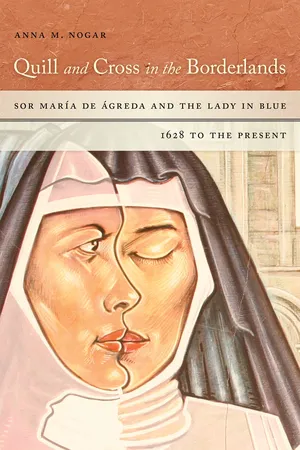
Quill and Cross in the Borderlands
Sor María de Ágreda and the Lady in Blue, 1628 to the Present
- 468 pages
- English
- ePUB (mobile friendly)
- Available on iOS & Android
Quill and Cross in the Borderlands
Sor María de Ágreda and the Lady in Blue, 1628 to the Present
About this book
Quill and Cross in the Borderlands examines nearly four hundred years of history, folklore, literature, and art surrounding the legendary Lady in Blue and her historical counterpart, Sor María de Jesús de Ágreda.
This legendary figure, identified as seventeenth-century Spanish nun and writer Sor María de Jesús de Ágreda, miraculously appeared to tribes in colonial-era New Mexico and taught them the rudiments of the Catholic faith. Sor María, an author of mystical Marian texts, became renowned not only for her alleged spiritual travel from her cloister in Spain to New Mexico but also for her writing, studied and implemented by Franciscans and others around the world. Working from original historical accounts, archival research, and a wealth of literature on the legend and the historical figure alike, Anna M. Nogar meticulously examines how and why the person and the legend became intertwined in Catholic consciousness and social praxis.
Nogar addresses the influence of Sor María's spiritual texts on many spheres of New Spanish and Spanish society over several centuries. Eventually, the historical Sor María and her writings virtually disappeared from view, and the Lady in Blue became a prominent folk figure in the present-day U.S. Southwest and U.S.-Mexico borderlands, appearing in folk stories, artwork, literature, theater, and public ritual that survives today. Quill and Cross in the Borderlands documents the material legacy of a legend that has survived and thrived for hundreds of years, and at the same time rediscovers the extraordinary impact of a hidden writer.
Frequently asked questions
- Essential is ideal for learners and professionals who enjoy exploring a wide range of subjects. Access the Essential Library with 800,000+ trusted titles and best-sellers across business, personal growth, and the humanities. Includes unlimited reading time and Standard Read Aloud voice.
- Complete: Perfect for advanced learners and researchers needing full, unrestricted access. Unlock 1.4M+ books across hundreds of subjects, including academic and specialized titles. The Complete Plan also includes advanced features like Premium Read Aloud and Research Assistant.
Please note we cannot support devices running on iOS 13 and Android 7 or earlier. Learn more about using the app.
Information
NOTES
INTRODUCTION
Table of contents
- Cover
- Halftitle
- Title
- Copyright
- Dedication
- Contents
- List of Illustrations
- Acknowledgments
- Introduction: A Literary Protomissionary in the Borderlands
- ONE Seventeenth-Century Spiritual Travel to New Mexico: A Miracle Narrative in Text
- TWO Sor María’s Rise as Mystical Writer and Protomissionary in Early Modern Spain
- THREE “Como si fuera natural de México”: Publication, Reading, and Interpretation of Sor María’s Writing in Colonial Mexico
- FOUR “Aquella voz de las conversiones”: Writer and Missionary on the New Spanish Frontier
- FIVE Blue Lady of Lore: The Lady in Blue Narrative and Sor María in the Folklore of the American Southwest
- SIX Sor María and the Lady in Blue in Contemporary Cultural Imagination
- Conclusion: Quill and Cross in the Borderlands
- Notes
- Bibliography
- Index